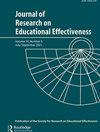外生时变混杂因素的倾向评分方法和差异中的差异:方法的评价
IF 1.6
4区 教育学
Q2 EDUCATION & EDUCATIONAL RESEARCH
Journal of Research on Educational Effectiveness
Pub Date : 2022-11-01
DOI:10.1080/19345747.2022.2128485
引用次数: 0
摘要
准实验设计(Quasi-experimental designs, QEDs)用于估计治疗效果而不进行随机化。混杂因素与治疗结果和采用治疗的概率有因果关系,如果没有解释,可能会对治疗效果估计产生偏差。在治疗前被认为是混杂因素的变量可能在治疗发生后发生变化(即时变混杂因素),而不是作为治疗的结果(我们称之为外源性时变混杂因素)。如果治疗后值对结果的变化有因果关系,并且外源性时变混杂因素的治疗后值未得到解释,则治疗效果可能存在偏差。我们回顾了Rubin因果模型和QED假设,以及外生时变混杂因素对QED产生适当反事实的能力的影响。我们进行了一项模拟研究,评估倾向评分和基于差异中的差异的方法,以估计外源性时变混杂因素的治疗效果。倾向得分加权的双向固定效应、逆概率加权或双稳健性差中差法,每一种方法都使用外源性时变混杂因素的实施后值估计倾向得分,当外源性时变混杂因素对治疗组和对照组的成员发生差异变化时,证明偏差最小。本文章由计算机程序翻译,如有差异,请以英文原文为准。
Propensity Score Methods and Difference-in-Differences with an Exogenous Time-Varying Confounder: Evaluation of Methods
Abstract Quasi-experimental designs (QEDs) are used to estimate a treatment effect without randomization. Confounders have a causal relationship with the outcome and probability of treatment adoption and if unaccounted for can bias treatment effect estimates. A variable considered a confounder prior to treatment can change after treatment has occurred (i.e., a time-varying confounder) not as a result of treatment (what we call an exogenous time-varying confounder). If the post-treatment value causally affects the outcome to change and this post-treatment value of the exogenous time-varying confounder is unaccounted for, then the treatment effect may be biased. We review the Rubin Causal Model and QED assumptions and the effect an exogenous time-varying confounder has on the ability of QEDs to produce an appropriate counterfactual. We conduct a simulation study evaluating propensity score and difference-in-differences based methods for estimating a treatment effect with an exogenous time-varying confounder. Propensity score weighted two-way fixed effects, inverse probability weighted, or doubly robust difference-in-differences methods, each with propensity scores estimated using post-implementation values of the exogenous time-varying confounder, proved least biased when the exogenous time-varying confounder changed differentially for members of the treatment and control groups.
求助全文
通过发布文献求助,成功后即可免费获取论文全文。
去求助
来源期刊

Journal of Research on Educational Effectiveness
EDUCATION & EDUCATIONAL RESEARCH-
CiteScore
4.00
自引率
11.10%
发文量
37
期刊介绍:
As the flagship publication for the Society for Research on Educational Effectiveness, the Journal of Research on Educational Effectiveness (JREE) publishes original articles from the multidisciplinary community of researchers who are committed to applying principles of scientific inquiry to the study of educational problems. Articles published in JREE should advance our knowledge of factors important for educational success and/or improve our ability to conduct further disciplined studies of pressing educational problems. JREE welcomes manuscripts that fit into one of the following categories: (1) intervention, evaluation, and policy studies; (2) theory, contexts, and mechanisms; and (3) methodological studies. The first category includes studies that focus on process and implementation and seek to demonstrate causal claims in educational research. The second category includes meta-analyses and syntheses, descriptive studies that illuminate educational conditions and contexts, and studies that rigorously investigate education processes and mechanism. The third category includes studies that advance our understanding of theoretical and technical features of measurement and research design and describe advances in data analysis and data modeling. To establish a stronger connection between scientific evidence and educational practice, studies submitted to JREE should focus on pressing problems found in classrooms and schools. Studies that help advance our understanding and demonstrate effectiveness related to challenges in reading, mathematics education, and science education are especially welcome as are studies related to cognitive functions, social processes, organizational factors, and cultural features that mediate and/or moderate critical educational outcomes. On occasion, invited responses to JREE articles and rejoinders to those responses will be included in an issue.
 求助内容:
求助内容: 应助结果提醒方式:
应助结果提醒方式:


